Pilum Vs. Soliferreum: Roman Spears
In the military history of Antiquity, the pilum and the soliferreum stand out as two types of throwing weapons that played a crucial role in combat tactics. While they shared similar purposes, their design and development exhibit notable differences. This detailed analysis explores their characteristics, functions, origins, and their relationship with other contemporary weapons.
Functional Similarities Between the Pilum and the Soliferreum
Both weapons had a clear purpose: to be thrown by the infantry just before close combat. Their primary function was to pierce enemy shields and armor, incapacitating the adversary or compromising their defense. This tactical use made them indispensable elements in the arsenal of the legions and other armies of the period.

In this sense, the pilum, the soliferreum, and other similar weapons like the falarica played a crucial strategic role. By incapacitating enemy shields, they facilitated a more advantageous close combat for the attacker.
Differences in Construction
Pilum: A Combination of Wood and Iron
- Structure: The pilum combined a relatively short wooden shaft with an elongated iron head that constituted a significant portion of its total length.
- Design: Depending on its era, different systems were used to join the shaft and the head, such as socket fittings or tangs with rivets. This design ensured that, upon impacting a shield, the tip remained embedded, making it difficult to remove.
Soliferreum: Fully Metallic
- Material: Unlike the pilum, the soliferreum was made entirely of iron.
- Shape: Its structure consisted of a circular-section shaft that thickened in the center for easier handling. It could also include moldings or facets to prevent slippage due to sweat.

Origin and Development of Both Weapons
The Pilum
The origin of the pilum is subject to debate. Some literary sources point to an Iberian inspiration, while archaeological evidence suggests parallel development in various regions. The oldest types included a socket fitting, which later evolved into the tang with rivets design characteristic of the Romans.
The Soliferreum
The earliest records of the soliferreum date back to the 6th century BCE, primarily in southern France. While some studies suggest that the pilum replaced it, other evidence indicates that both coexisted and evolved independently according to regional needs.
Relationship with Other Weapons
Falarica
The falarica is described in classical sources as a heavy javelin primarily used in the Iberian Peninsula. Its functional similarity to the pilum links it to the framework of throwing weapons of the era.
Gaesum
The gaesum, another term for javelins of various types, was common among Celtic and Iberian peoples. Athenaeus noted that the use of the gaison (a related term) was adopted by the Romans, although its design varied depending on the region and culture.
A Technology of Convergence
The similarity between the pilum, the soliferreum, and other similar weapons in different cultures suggests a phenomenon of technological convergence, where distinct societies independently developed similar weapons due to common tactical needs. This fact highlights how the conditions of combat shaped the military innovations of the time.

General Comparison
| Category | Pilum | Soliferreum |
| Construction | Wood and iron | All iron |
| Origin | Debated (Iberian inspiration) | Southern France, 6th century BCE |
| Use | Thrown to incapacitate shields | Thrown to pierce enemy defenses |
The analysis of these weapons reveals not only their specific roles in ancient warfare but also the diversity of technical responses to the challenges of combat in different cultures.
















